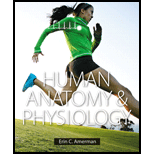
Human Anatomy & Physiology
1st Edition
ISBN: 9780805382952
Author: Erin C. Amerman
Publisher: PEARSON
expand_more
expand_more
format_list_bulleted
Concept explainers
Textbook Question
Chapter 2.2, Problem 1QC
What is a mixture?
Expert Solution & Answer
Want to see the full answer?
Check out a sample textbook solution
Students have asked these similar questions
What are P elements?
Which compounds are enantiomers?
What is Alu element ?
Chapter 2 Solutions
Human Anatomy & Physiology
Ch. 2.1 - Prob. 1QCCh. 2.1 - What are atoms?Ch. 2.1 - How do the three types of subatomic particles...Ch. 2.1 - What is an element?Ch. 2.1 - 4. How are elements arranged in the periodic...Ch. 2.1 - What are isotopes?Ch. 2.1 - Prob. 1AWYLCh. 2.1 - The element lithium has an atomic number of 3 and...Ch. 2.2 - What is a mixture?Ch. 2.2 - 2. How do the three types of mixtures differ?
Ch. 2.2 - Prob. 3QCCh. 2.2 - What is an ionic bond?Ch. 2.2 - 5. How is an ionic bond formed?
Ch. 2.2 - 6. Explain how polar and nonpolar covalent bonds...Ch. 2.2 - What are hydrogen bonds? Why do hydrogen bonds...Ch. 2.2 - Which would be more reactive-an atom of fluorine...Ch. 2.2 - Would a molecule of hydrogen (H2) form hydrogen...Ch. 2.2 - Explain why the molecule Na2 does not exist in...Ch. 2.3 - Prob. 1QCCh. 2.3 - Prob. 2QCCh. 2.3 - How do endergonic and exergonic reactions differ?Ch. 2.3 - Prob. 4QCCh. 2.3 - What factors can influence the rate of a chemical...Ch. 2.3 - 6. What is an enzyme, and what does an enzyme do?
Ch. 2.3 - Prob. 1AWYLCh. 2.3 - Explain why most biological molecules are stable...Ch. 2.3 - 3. Many naturally occurring poisons function by...Ch. 2.4 - What are four properties of water that make it a...Ch. 2.4 - 2. Which molecules are likely to be hydrophilic?...Ch. 2.4 - 3. Define the terms acid and base.
Ch. 2.4 - What is the pH scale? Which pH values are...Ch. 2.4 - What is the effect of a buffer on a solution?Ch. 2.4 - What is a salt?Ch. 2.4 - 7. What does an electrolyte do in a solution?
Ch. 2.4 - Explain how the water surrounding a fetus in the...Ch. 2.4 - Prob. 2AWYLCh. 2.5 - 1. How do polymers and monomers differ?
Ch. 2.5 - 2.3. How do monosaccharides, disaccharides, and...Ch. 2.5 - 2. How do monosaccharides, disaccharides, and...Ch. 2.5 - How are two monosaccharides linked to form a...Ch. 2.5 - Prob. 5QCCh. 2.5 - 5. How do phospholipids and triglycerides differ?
Ch. 2.5 - What are steroids?Ch. 2.5 - Prob. 8QCCh. 2.5 - How are amino acids linked to form peptides and...Ch. 2.5 - What are the four levels of structural...Ch. 2.5 - 10. What are the components and roles of ATP?
Ch. 2.5 - 11. How do DNA and RNA differ?
Ch. 2.5 - 11. What are the three components of a...Ch. 2.5 - Which molecule would be the most soluble in water:...Ch. 2.5 - In Module 2.3, you learned that increasing...Ch. 2.5 - 3. How could a defect in a gene lead to a...Ch. 2 - Prob. 1CYRCh. 2 - Fill in the blanks: Isotopes are atoms with the...Ch. 2 - 3. Which of the following statements correctly...Ch. 2 - 4. Explain the difference between an ionic and a...Ch. 2 - Identify each of the following molecules or...Ch. 2 - What are hydrogen bonds, and how do they form?Ch. 2 - Prob. 7CYRCh. 2 - Prob. 8CYRCh. 2 - Which of the following would not result in an...Ch. 2 - 10. An enzyme is a:
a. biological catalyst that...Ch. 2 - Prob. 11CYRCh. 2 - With respect to their solubility in water,...Ch. 2 - Mark the following statements as true or false. If...Ch. 2 - A salt is: a. a metal cation bonded to a nonmetal...Ch. 2 - 15. Compare and contrast the structures of...Ch. 2 - 16. Mark the following statements as true or...Ch. 2 - 17. Why is it important for a protein to maintain...Ch. 2 - Which of the following is not part of a...Ch. 2 - 19. Mark the following properties as belonging to...Ch. 2 - Which of the following statements is/are true...Ch. 2 - 1. In certain types of radioactive decay, the...Ch. 2 - Considering that water is a main component of the...Ch. 2 - 3. Explain why monosaccharides are polar and fatty...Ch. 2 - 1. The polysaccharide cellulose is not digestible...Ch. 2 - Some claim that the pH of your blood can be...Ch. 2 - Prob. 3AYKCh. 2 - Prob. 5AYKCh. 2 - You have just dropped some phospholipids into...
Knowledge Booster
Learn more about
Need a deep-dive on the concept behind this application? Look no further. Learn more about this topic, biology and related others by exploring similar questions and additional content below.Similar questions
arrow_back_ios
arrow_forward_ios
Recommended textbooks for you
 Biology Today and Tomorrow without Physiology (Mi...BiologyISBN:9781305117396Author:Cecie Starr, Christine Evers, Lisa StarrPublisher:Cengage Learning
Biology Today and Tomorrow without Physiology (Mi...BiologyISBN:9781305117396Author:Cecie Starr, Christine Evers, Lisa StarrPublisher:Cengage Learning Principles Of Radiographic Imaging: An Art And A ...Health & NutritionISBN:9781337711067Author:Richard R. Carlton, Arlene M. Adler, Vesna BalacPublisher:Cengage Learning
Principles Of Radiographic Imaging: An Art And A ...Health & NutritionISBN:9781337711067Author:Richard R. Carlton, Arlene M. Adler, Vesna BalacPublisher:Cengage Learning

Biology Today and Tomorrow without Physiology (Mi...
Biology
ISBN:9781305117396
Author:Cecie Starr, Christine Evers, Lisa Starr
Publisher:Cengage Learning

Principles Of Radiographic Imaging: An Art And A ...
Health & Nutrition
ISBN:9781337711067
Author:Richard R. Carlton, Arlene M. Adler, Vesna Balac
Publisher:Cengage Learning
Macromolecules | Classes and Functions; Author: 2 Minute Classroom;https://www.youtube.com/watch?v=V5hhrDFo8Vk;License: Standard youtube license